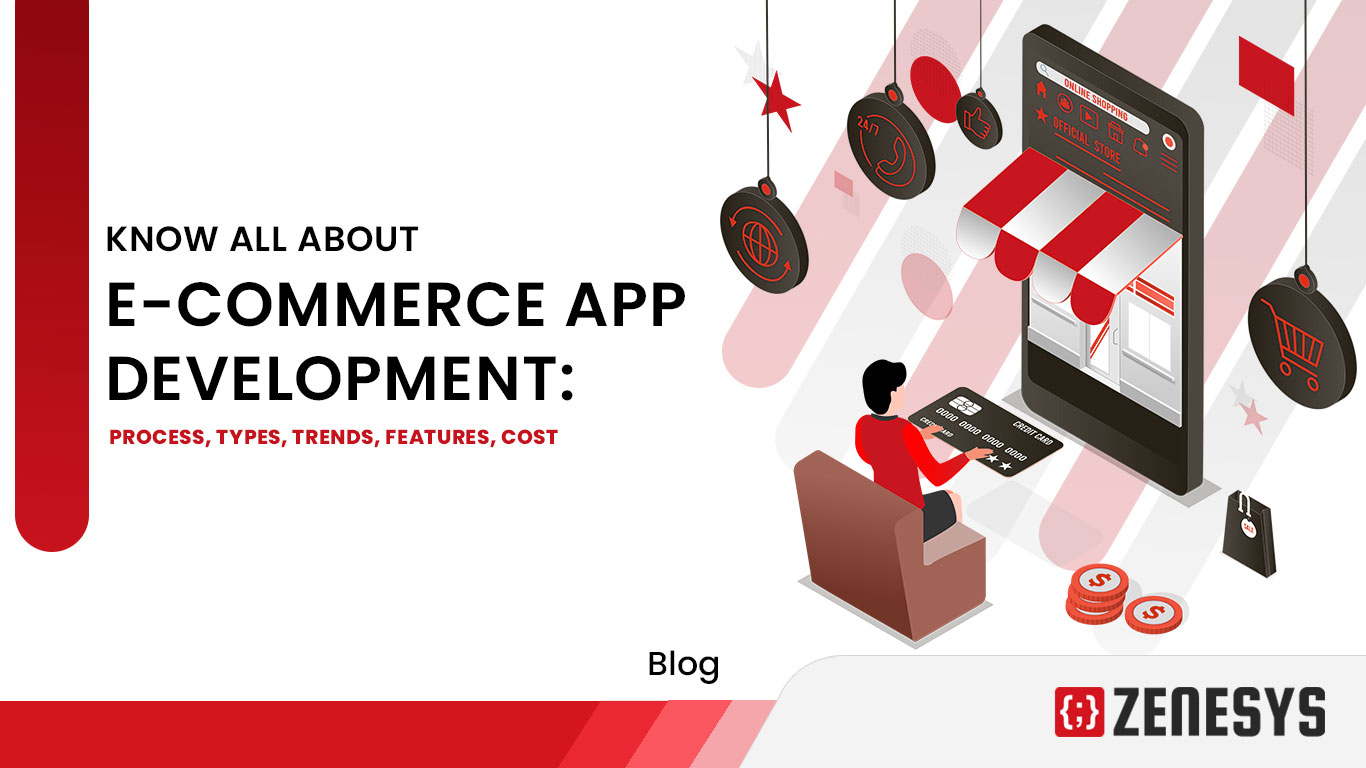
Are you one of those people who shop online regularly: shoes, shades, pills, and desks? The E-commerce business is surely one of the most widely expanded. And who doesn’t use online services? Even E-commerce owners fall among them. Intense periods of lockdown accelerated the expansion of the E-commerce app industry.
If you are already an established E-commerce application development company, you may be looking to expand your clientele and revenues. The solution is simple: build an app to facilitate online shopping. So let’s discuss, in this article, the nuts and bolts of E-commerce app development.
E-commerce App Development Process
A step-by-step process can make your app more efficient for handling varying tasks. E-commerce is a diversifying industry, and therefore one needs to be strategic in this. So let’s look at the process:
The key to creating compelling user experiences and tales that keep customers coming back for more is to first understand the app's target audience. Finding the app's target demographic and learning about their interests helps determine the app's specialization.
The final offering to clients who visit the online shop will determine the best course of action. Customization and scalability are both possible with app development. Finding a technological collaborator who offers bespoke app development services will allow you to realize your ideal product.
To keep their return on investment (ROI) comfortable, business owners must ensure that no requests for the app's development go above the budget projections at any moment, even while working with an agile software development firm.
1. Your Goal
Knowing what you want to achieve is the first and foremost thing in E-commerce app development. Be detailed when outlining goals to allow time for planning the integration of developing features. The goal should be to glean useful information from the app that can be used to hone the company's offerings.2. Target Audience
Customers are the ones who will determine the success or failure of the supplementary E-commerce app. Therefore, it is crucial to precisely chart the user base, including their demographics, interests, opinions, and complaints about the program.The key to creating compelling user experiences and tales that keep customers coming back for more is to first understand the app's target audience. Finding the app's target demographic and learning about their interests helps determine the app's specialization.
3. Tech Advancements
As we now understand the users of the app being produced and the functions it will do, the following step is to identify what sort of an app is needed in single vendor or multivendor E-commerce app development process. There are two main options for E-commerce apps: PWAs and Native apps.The final offering to clients who visit the online shop will determine the best course of action. Customization and scalability are both possible with app development. Finding a technological collaborator who offers bespoke app development services will allow you to realize your ideal product.
4. Cost Planning
While considerable effort goes into identifying or wishing to add features and functions in the E-commerce app, it is important to keep in mind how these needs relate to the available budget.To keep their return on investment (ROI) comfortable, business owners must ensure that no requests for the app's development go above the budget projections at any moment, even while working with an agile software development firm.
5. The Launch
There will always be vulnerabilities, no matter how meticulous the E-commerce app development process is or how brilliant the minds behind the planning are. Standard operating procedures for developing apps should always include extensive testing of the app's load, regression, device, performance, responsiveness, and usability. Make sure the team has competent testers in order to produce high-quality documentation following testing.E-commerce App Development Types

Below are the various E-commerce app development types:
1. Aggregators E-commerce App
The idea of creating apps that aggregate several online stores into one is novel. In practice, though, such an app serves as an aggregator. Apps offering a wide range of pickup and delivery, storage, and transportation services are built into this framework. Therefore, your facilities are unnecessary. The supplier will then be able to provide you access to the aggregators' offerings.2. B2B Apps
A B2B E-commerce app is one that facilitates transactions between businesses. This subset of E-commerce app development concentrates on fulfilling orders from one company to another. B2B E-commerce solutions also help firms bring in more money. This is why they require the creation of B2B E-commerce applications.3. B2C Apps
Web developers often create applications that facilitate business-to-consumer E-commerce. It communicates with a company that sells directly to consumers. The administration here is very quick to respond to any consumer concerns. An Amazon-style E-commerce app development is another option, as is one that caters to a certain niche market. Products associated with a specific field are offered for sale.4. C2C Apps
Here, the exchange takes place between a minimum of two clients. One particularly useful scenario for this use is the marketing and sale of niche products. We might initially be puzzled by a strategy involving a consumer and a vendor. Popular examples of such programs are eBay and Amazon.5. C2B Apps
Despite the scarcity of this type of software, companies are nevertheless actively developing it. They provide doable outcomes across the board. C2B E-commerce programs are a great way for professionals to market their services to businesses. Adding a shopper to your action plan may be a novel concept. UpWork, Freelancer, and other online job boards are prime examples of this trend.6. Online Reservation & Purchasing App
Mobile ticketing E-commerce apps allow users to purchase seats for a show or concert on the go. Ticketing for events of all kinds may be arranged with the help of E-commerce app development. There is no need for a massive infrastructure to support contributors to such apps.7. Bidding or Auction Apps
The creation of auction and bidding E-commerce applications have recently become popular. In addition, it can help cut down on the price of holding auctions. You may also find auction and bidding applications that work independently.
Click here if you want to know about E-commerce product development strategy.
E-commerce App Development Trends 2024
A fresh look arrives with each passing year. Consistency in execution pays off for businesses with devoted customers and concrete gains. In 2024, these will be the most prominent practices in building E-commerce apps.
Users may now visualize themselves in the desired environments in stunning 3D without ever having to leave their chairs. Nike, for one, made advantage of this function so that shoppers could virtually try on a selection of footwear prior to making a purchase.
One of the most rapidly expanding sectors of the mobile app industry is targeted toward developing nations. But now, because of the proliferation of cheap cell phones, people in many locations can access mobile content. This pattern persists.
1. Augmented Reality
There's a brand-new, fascinating feature that can't be overlooked in any discussion on mobile E-commerce app development trends. Augmented reality has revolutionized the online shopping app user experience.Users may now visualize themselves in the desired environments in stunning 3D without ever having to leave their chairs. Nike, for one, made advantage of this function so that shoppers could virtually try on a selection of footwear prior to making a purchase.
2. DeGlobalization
In 2024, deglobalization will be another direction for mobile app development. The term "disconnected society" describes the current technological trend.One of the most rapidly expanding sectors of the mobile app industry is targeted toward developing nations. But now, because of the proliferation of cheap cell phones, people in many locations can access mobile content. This pattern persists.
3. Voice Search
Users often find it difficult to type on a mobile device's small screen. That's why it's so remarkable how useful voice search has grown in this respect. When consumers can shop more conveniently by talking to their mobile devices instead of typing, everyone wins.E-commerce App Development Features

Here are some prominent features that you can choose to include in your e-commerce app to keep your customers engaged:
1. Buy-Now-Pay-Later
More and more shoppers anticipate having the option to "buy now, pay later" (BNPL) with a service like Afterpay. Users can make a purchase now and pay for it in many payments afterward. In fact, by 2026, BNPL deals are projected to rise by more than $450 billion. According to certain reports, BNPL is preferred by customers and merchants alike for making large, installment purchases and payments.2. Livestream Shopping
This is another great feature of E-commerce app development that you can incorporate. A common practice among live streamers is to pin a direct link to a product profile that features the brand's wares. Live streaming has had a 10x greater conversion rate than other elements on E-commerce websites in the last year.3. Social Media Integration
When it comes to retail technology, social media integration is the most powerful and significant E-commerce element. Customers can more easily utilize your app's login, registration, and product-sharing features if you incorporate social media.Sharing discount coupons and other marketing efforts with friends and followers is another convenient aspect of mobile E-commerce app development. Additionally, students may share their app-earned accomplishments. More customers will get familiar with your company and product as a result.
4. Rating and Feedback
The ability to rate and provide comments is a staple of most E-commerce apps. It's easy to assume that users are the only ones who can gain anything from a reporting or feedback system. Any comments or suggestions users have about your app might help you make it better.This is a fantastic feature for your app since it allows users to rate it in a public forum. Positive ratings are thought to attract more users via word of mouth.
E-commerce App Development Cost
The cost of the solution is variable. Planning ahead is essential in software development to prevent surprises, redos, and excessive spending. However, getting a customer's technological requirements is the first step in creating E-commerce software. The paper specifies the requirements the client has for the software. A consistent technical demand calls for a specific set of skills and backgrounds.
Another way is consulting. You always have the option to consult with experts or get free quotes from service providers. They will judge your requirements and provide you with a more proper cost breakdown. Then you can continue with them or even also hire some freelancers who provide E-commerce app development services. In the case of freelancers also you will have an overview of the budget. That will make your decisions easier.
Another way is consulting. You always have the option to consult with experts or get free quotes from service providers. They will judge your requirements and provide you with a more proper cost breakdown. Then you can continue with them or even also hire some freelancers who provide E-commerce app development services. In the case of freelancers also you will have an overview of the budget. That will make your decisions easier.
Conclusion
Despite the industry's dramatic ascent, E-commerce remains a lucrative shelter for entrepreneurs and investors. The large user base space is accumulating and the ongoing technical developments make this an ideal time for businesses to enter the market.
In this article, we’ve known the a brief cost of making an E-commerce app, its process, types, and features, and the latest trends in the industry as well. We expect that this tutorial has provided you with some foundational knowledge about what an effective E-commerce app development process looks like.
As a business owner, if you want to expand your business and reach new heights of success, you should consider an E-commerce app. Are you ready to level up your competitive game? Contact our team and hire Zenesys to transform your E-commerce app idea into a real business.
In this article, we’ve known the a brief cost of making an E-commerce app, its process, types, and features, and the latest trends in the industry as well. We expect that this tutorial has provided you with some foundational knowledge about what an effective E-commerce app development process looks like.
As a business owner, if you want to expand your business and reach new heights of success, you should consider an E-commerce app. Are you ready to level up your competitive game? Contact our team and hire Zenesys to transform your E-commerce app idea into a real business.
FAQs
1. Key Factors to Consider When Choosing an E-Commerce App Development Platform
Selecting the right e-commerce app development platform is crucial for your business success. Here are the main factors to consider:
The more complex an e-commerce app is, the higher its development cost. Here’s why:
The average development time for an e-commerce app typically ranges from 3 to 9 months, depending on the complexity of the app and the size of the development team:
4. Essential Features for a Successful E-Commerce App
To create a successful e-commerce app, certain features are essential:
5. How to Stay Updated with the Latest Trends and Technologies in E-Commerce App Development
To stay current with trends and technology in e-commerce app development, consider these approaches:
Selecting the right e-commerce app development platform is crucial for your business success. Here are the main factors to consider:
- Scalability: Look for a platform that can grow with your business. As your customer base expands, you’ll need a platform to handle increased traffic and orders.
- Customization Options: A flexible platform allows you to tailor the app’s design, features, and user interface to match your brand’s identity.
- Integration Capabilities: Choose a platform that can seamlessly integrate with other tools you use, like payment gateways, inventory management, and CRM systems.
- Security: Security is essential for protecting customer data. Could you make sure the platform offers robust security features, such as data encryption and compliance with industry standards like PCI-DSS?
- Cost: The platform should fit your budget, not only for initial development but also for ongoing maintenance and upgrades.
- Support and Community: Platforms with strong support and active developer communities can be valuable for troubleshooting and future enhancements.
The more complex an e-commerce app is, the higher its development cost. Here’s why:
- Follow Industry Blogs and News: Websites like TechCrunch, E-commerce Times, and industry blogs regularly update on new trends and technologies.
- Attend Webinars and Conferences: Events like eCommerce Expo and industry-specific webinars offer insights into innovations and best practices.
- Join Developer Communities: Platforms like GitHub, Stack Overflow, and Reddit have active communities where developers share knowledge and the latest updates.
- Network with Other Developers: Connecting with other developers and businesses in the e-commerce space can keep you informed on what’s working and what’s trending.
- Experiment with New Tools: Try out emerging tools and frameworks. Staying hands-on can help you quickly adapt and understand new technologies. Being proactive in learning and experimenting helps you adapt to new developments and gives your app a competitive edge.
The average development time for an e-commerce app typically ranges from 3 to 9 months, depending on the complexity of the app and the size of the development team:
- Simple Apps: Basic e-commerce apps with essential features like a product catalog, shopping cart, and checkout process usually take around 3–4 months to develop.
- Medium Complexity Apps: Apps with additional features, like order tracking, personalized recommendations, and basic analytics, may take 5–7 months.
- Highly Complex Apps: For apps with advanced features like AR, AI-powered recommendations, and multi-language support, development can extend to 9 months or more. Regular updates and improvements are also necessary post-launch to keep the app relevant and efficient.
4. Essential Features for a Successful E-Commerce App
To create a successful e-commerce app, certain features are essential:
- User-Friendly Interface: A clear, simple, and engaging interface is crucial for user satisfaction and retention.
- Secure Payment Options: Offer multiple secure payment methods, like credit/debit cards, digital wallets, and bank transfers, to increase convenience and trust.
- Product Search and Filters: Advanced search options and filters help users quickly find what they’re looking for.
- Personalization: Features like recommended products and personalized deals improve user experience and can increase sales.
- Customer Support: Integrating a chatbot or customer support option is essential to assist users in real time.
- Order Tracking: Providing order tracking keeps customers informed and builds trust. These features create a seamless and efficient shopping experience, keeping users engaged and satisfied.
5. How to Stay Updated with the Latest Trends and Technologies in E-Commerce App Development
To stay current with trends and technology in e-commerce app development, consider these approaches:
- Follow Industry Blogs and News: Websites like TechCrunch, E-commerce Times, and industry blogs regularly update on new trends and technologies.
- Attend Webinars and Conferences: Events like eCommerce Expo and industry-specific webinars offer insights into innovations and best practices.
- Join Developer Communities: Platforms like GitHub, Stack Overflow, and Reddit have active communities where developers share knowledge and latest updates.
- Network with Other Developers: Connecting with other developers and businesses in the e-commerce space can keep you informed on what’s working and what’s trending.
- Experiment with New Tools: Try out emerging tools and frameworks. Staying hands-on can help you quickly adapt and understand new technologies. Being proactive in learning and experimenting helps you adapt to new developments and gives your app a competitive edge.


.webp?lang=en-US&ext=.webp)

.webp?lang=en-US&ext=.webp)
